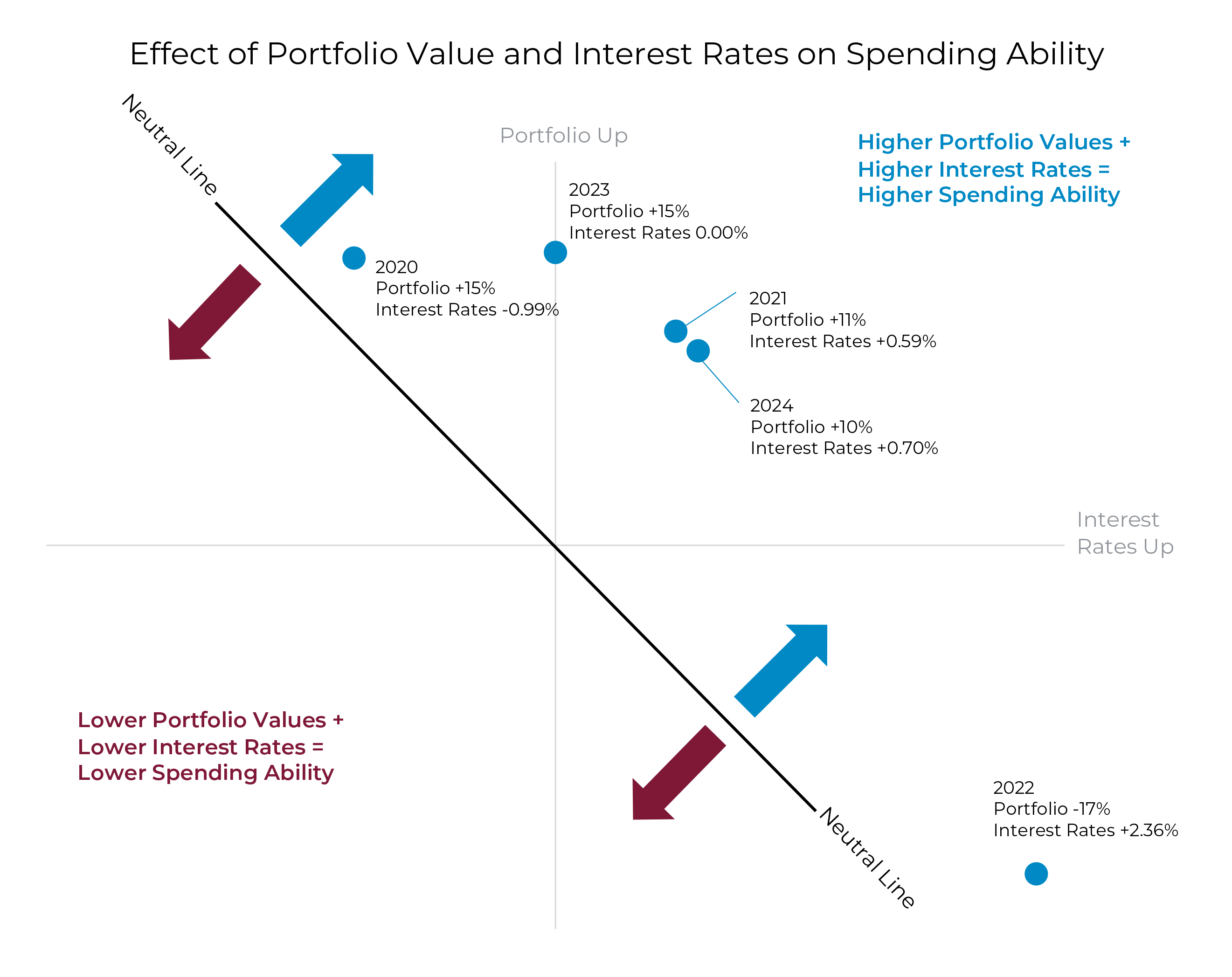Examining the last few years based on market returns, it would be easy to say that every year except for 2022 was great. It is natural human behavior to think about up markets as good and down markets as bad. In the reality of financial planning, things are not so simple. What really matters is how much spending your portfolio can support in the future — your spending ability.
There are three factors that impact potential spending ability from a portfolio:
- The value of the portfolio
- Any future contributions or withdrawals
- Expected future portfolio returns
The portfolio value and your contributions to the portfolio are straightforward data points. We know today’s value of the portfolio. With a little bit of budgeting, we can estimate your future income and expenses, so we should be able to estimate future contributions or withdrawals from the portfolio.
When it comes to the third factor — expected returns — higher long-term government bond yields are a rising tide that lifts all boats. Let’s break down what that means.
There is a strong, positive historical relationship between the long-term government bond yield and expected stock returns. That is, stocks tend to return more when interest rates are higher. Boiling down the academic research on this topic, investors require a higher expected return to invest in riskier stocks rather than safer bonds — known as the equity risk premium — and academics’ best guess of that risk premium is about 5% more per year in return. In addition, rising long-term government bond yields increase the expected return of bonds as well as stocks!
If we go through the past few years, we can use this lens to examine what happened to a typical investor’s spending ability, especially during the two big downturns in 2020 and 2022.
(When referencing stock returns and bond interest rates, we will be referring to the MSCI World Index for stocks and the US 10-Year Treasury, respectively. Any reference to a 60% stock and 40% bond investment is 60% MSCI World Index and 40% Bloomberg US Treasury Bellwether 10-Year Bond Index. For illustrative and educational purposes only. Not intended to represent any Forum strategy.)
Future Spending Ability Was Basically Flat in 2020
Even though the stock market dropped 32% from peak to trough in March 2020, the market fully rebounded and then some by the end of the year.1 From a portfolio perspective, 2020 was a good year. However, bond yields dropped from 1.92% at the beginning of 2020 to 0.93% at the end, forecasting lower bond and stock returns going forward.
In other words, stock markets did well, but bond yields went down (i.e., expected returns of both stocks and bonds went down), so the net effect was a slightly positive year for most investors from a future cash flow standpoint.
Future Spending Ability Was Up in 2022, Really!
It is not easy to forget the panic that gripped investors in 2022. Many investors were fearful of the market, understandably so.
A portfolio of 60% stocks and 40% bonds was down about –17% in 2022 with both stocks and bonds dropping similarly in value. However, the silver lining was that bond yields increased from 1.52% at the beginning of 2022 to 3.88% at the end … meaning that expected returns for stocks and bonds went up … by a lot.
Even though portfolio values were down in 2022, this jump in expected returns meant that spending ability surprisingly went up in 2022 for most investors. Yes, this is a very counterintuitive result! Even with portfolios down in value, expected returns jumped by enough to more than offset the decline, creating more secure outlooks and retirements for investors in the long run.
Future Spending Ability Increased Quite a Bit These Past Five Years
Below is a visual look at the last five years in terms of portfolio return and change in bond yields. What is really striking is that all of the last five years were neutral or positive in terms of increasing future spending ability — especially the last four. We have to go back to 2018 to find a year when expectations of future wealth and spending ability declined.
This chart uses the return of a portfolio of 60% stocks and 40% bonds to show a hypothetical investor’s portfolio return and the yield of 10-year U.S. Treasury Bonds for interest rates. Anything up and right of the neutral line represents a straight-line increase in spending for an investor who plans to invest at least another 10 years. Notice that all five blue dots, which represent years 2020–2024, are up and to the right of the neutral line — representing higher spending ability each year.

Looking at 2024 Through a Financial Planning Lens
The 10-year U.S. Treasury bond yield ended 2023 at 3.88% and rose to 4.58% by the end of 2024, thus increasing bond and stock expected returns going forward as mentioned earlier (remember that rising long-term government bond yields increase the expected returns of stocks and bonds). The combination of higher portfolio values and higher future expected returns means that long-term wealth and spending ability look stronger than ever.
2024 ended up being a strong continuation of the last five years, providing investors with the best outlook for retirement spending and long-term portfolio values yet.
Conclusion
As the Eagles sang in “The Long Run”: “Well, we’re scared, but we ain’t shakin’. Kind of bent, but we ain’t breakin’ in the long run.”2
Viewing the world through portfolio values alone, the last few years felt scary with the drop in the market in early 2020 and the drop across stocks and bonds in 2022. However, when we view the world in terms of long-term spending and wealth, the last five years have added a significant amount of long-term security and financial flexibility for disciplined investors.
SOURCES
1 Weekly MSCI World data sourced from https://www.statista.com/statistics/1253899/msci-world-index-weekly/.
2 Don Henley and Glenn Frey, “The Long Run.” “The Long Run,” Elektra/Asylum Records, 1979.
All index returns sourced from Dimensional Returns Web.
All Treasury Bond Yield data sourced from https://home.treasury.gov/resource-center/data-chart-center/interest-rates/TextView?type=daily_treasury_yield_curve&field_tdr_date_value=2024.
The MSCI World Index captures large and mid-cap representation across 23 Developed Markets (DM) countries*. With 1,395 constituents, the index covers approximately 85% of the free float-adjusted market capitalization in each country.
The Bloomberg US Treasury Bellwether Indices are a series of benchmarks tracking the performance and attributes of eight on-the-run US Treasuries that reflect the most recently issued 3m, 6m, 2y, 3y, 5y, 10y and 30y securities. The Bellwether indices follow the Bloomberg Fixed Income Indices’ monthly rebalancing conventions.
All investment strategies carry the potential for both profit and loss, and different types of investments involve varying levels of risk. Past performance is not indicative of future results and should not be relied upon as a guarantee of future success. Consequently, it should not be assumed that the future performance of any specific investment or strategy will be profitable, suitable for your portfolio or individual circumstances, or otherwise successful. Furthermore, any information presented should not be interpreted as a receipt of, or substitute for, personalized investment advice from Forum.
Historical index performance data referenced, directly or indirectly, is based on information from the respective copyright holders, trademark owners, or publication/distribution right owners of each index. Index performance does not account for the deduction of transaction fees, custodial charges, or management fees, which would reduce historical performance results. Indexes are unmanaged, and investors cannot invest directly in an index.
By clicking on a third-party link, you will leave the Forum website. Forum is linking to this third-party site to share information in a different format and is for informational purposes only. However, Forum cannot attest to the accuracy of information provided by this site or any other linked site. Forum does not endorse the site sponsors or the information or products presented there. Privacy and security policies may differ from those practiced by Forum.





